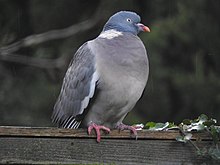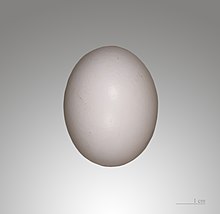
The rock dove, rock pigeon, or common pigeon is a member of the bird family Columbidae. In common usage, it is often simply referred to as the "pigeon", although this is the wild form of the bird; the pigeons most familiar to people are the domesticated form of the wild rock dove.

The stock dove or stock pigeon is a species of bird in the family Columbidae, the doves and pigeons. It is widely distributed in the western Palearctic.

The European turtle dove is a threatened or vulnerable member of the bird family Columbidae, the doves and pigeons. It breeds over a wide area of the south western Palearctic including north Africa but migrates to northern sub-Saharan Africa to winter.
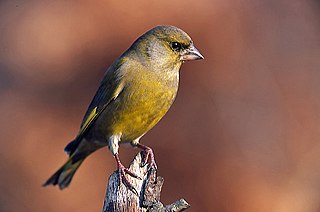
The European greenfinch or simply the greenfinch is a small passerine bird in the finch family Fringillidae.
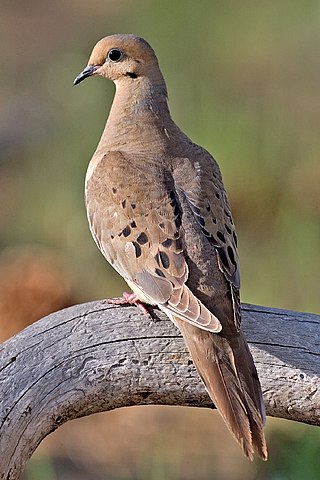
The mourning dove is a member of the dove family, Columbidae. The bird is also known as the American mourning dove, the rain dove, the chueybird, colloquially as the turtle dove, and it was once known as the Carolina pigeon and Carolina turtledove. It is one of the most abundant and widespread North American birds and a popular gamebird, with more than 20 million birds shot annually in the U.S., both for sport and meat. Its ability to sustain its population under such pressure is due to its prolific breeding; in warm areas, one pair may raise up to six broods of two young each in a single year. The wings make an unusual whistling sound upon take-off and landing, a form of sonation. The bird is a strong flier, capable of speeds up to 88 km/h (55 mph).

The bird genus Columba comprises a group of medium to large pigeons. The terms "dove" and "pigeon" are used indiscriminately for smaller and larger Columbidae, respectively. Columba species – at least those of Columba sensu stricto – are generally termed "pigeons", and in many cases wood-pigeons. The rock dove has given rise to the majority of domesticated pigeon breeds, such as the racing pigeon and the fantail pigeon, some of which have become feral. Meanwhile, "wood pigeon" by itself usually means the common wood pigeon.
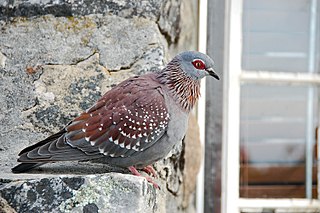
The speckled pigeon, also African rock pigeon or Guinea pigeon, is a pigeon that is a resident breeding bird in much of Africa south of the Sahara. It is a common and widespread species in open habitats over much of its range, although there are sizable gaps in its distribution. It is sometimes referred to as the Guinea pigeon due to its similar coloring to some species of guineafowl.

The laughing dove is a small pigeon that is a resident breeder in Africa, the Middle East, South Asia, and Western Australia where it has established itself in the wild after being released from Perth Zoo in 1898. This small long-tailed dove is found in dry scrub and semi-desert habitats where pairs can often be seen feeding on the ground. It is closely related to the spotted dove which is distinguished by a white and black chequered necklace. Other names include laughing turtle dove, palm dove and Senegal dove while in Asia the name little brown dove is often used.

The vinaceous dove is a bird species in the pigeon family Columbidae that widely resident across the Sahel and Sudan (region).

The emerald dove or common emerald dove, also called Asian emerald dove and grey-capped emerald dove, is a widespread resident breeding pigeon native to the tropical and subtropical parts of the Indian Subcontinent and Southeast Asia. The dove is also known by the names of green dove and green-winged pigeon. The common emerald dove is the state bird of the Indian state of Tamil Nadu. The Pacific emerald dove and Stephan's emerald dove were both considered conspecific.

The trocaz pigeon, Madeira laurel pigeon or long-toed pigeon is a pigeon which is endemic to the island of Madeira, Portugal. It is a mainly grey bird with a pinkish breast; its silvery neck patch and lack of white wing markings distinguish it from its close relative and probable ancestor, the common wood pigeon. Its call is a characteristic six-note cooing, weaker and lower-pitched than that of the wood pigeon. Despite its bulky, long-tailed appearance, this pigeon has a fast, direct flight.

Bolle's pigeon, Bolle's laurel pigeon or dark-tailed laurel pigeon is a species of the genus Columba of family Columbidae, doves and pigeons, endemic to the Canary Islands, Spain. This bird is named after the German naturalist Carl Bolle, who was the first to distinguish it from the laurel pigeon. This wood pigeon is endemic to the laurel forest habitat.

The laurel pigeon or white-tailed laurel pigeon is a species of bird in the Columba genus in the family Columbidae. It is endemic to the Canary Islands, Spain, and resides in laurel forest habitat. It is the animal symbol of the island of La Gomera.
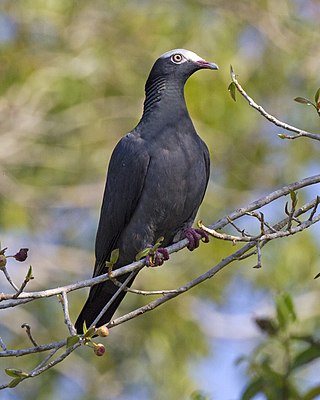
The white-crowned pigeon is a fruit and seed-eating species of bird in the dove and pigeon family Columbidae. It is found primarily in the Caribbean.

The scaled pigeon is a large New World tropical dove. It is a resident breeder from southern Mexico south to western Ecuador, southern Brazil, northern Argentina, and Trinidad.

The zebra dove, also known as the barred ground dove, or barred dove, is a species of bird of the dove family, Columbidae, native to Southeast Asia. They are small birds with a long tail, predominantly brownish-grey in colour with black-and-white barring. The species is known for its pleasant, soft, staccato cooing calls.

The ruddy quail-dove is a species of bird in the dove and pigeon family Columbidae. It breeds throughout the West Indies, Central America, and tropical South America. It has appeared as a vagrant in Florida and southern Texas. It lays two buff-colored eggs on a flimsy platform built on a shrub. Some nests are built on the ground.

The blue-headed quail dove, or blue-headed partridge-dove, is a species of bird in the pigeon and dove family Columbidae. It is monotypic within the subfamily Starnoenadinae and genus Starnoenas.
In the 10th edition of Systema Naturae, published in 1758, the Swedish naturalist Carl Linnaeus described 554 species of bird and gave each a binomial name.

The Azores wood pigeon, Columba palumbus azorica is an endemic subspecies of the common wood pigeon, located in the Atlantic Azores islands of Portugal. This endemic subspecies is the only live pigeon present in the laurel forest habitat of the Azores Islands.


